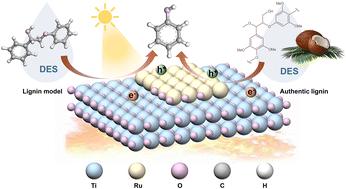Lignin refinement based on efficient thermo-photo-catalysis of Ru–RuO2/TiO2-deep eutectic solvents
IF 9.2
1区 化学
Q1 CHEMISTRY, MULTIDISCIPLINARY
引用次数: 0
Abstract
Lignin refinement with high yields and high selectivities towards aromatic monomers under mild conditions is challenging. A thermo-photo-catalysis system based on deep eutectic solvents (DESs) and Ru–RuO2/TiO2 is described here and exhibits excellent oxidation depolymerization performance towards both model lignin compounds and coconut shell lignin under mild conditions. When using the β-O-4 model substrate, a 99.45% conversion rate was achieved with a phenol yield of 99.34% at 80 °C, 1 MPa O2, 300 W visible light irradiation, and the presence of glycerol–choline chloride (Gly–ChCl) DES for 2 hours. More importantly, the raw material of coconut shell gave a phenol yield of 27.5% (w/w) due to the high productivity of 87.65% for authentic lignin in tetramethylammonium hydroxide–imidazole (TMAH–imidazole) DES at 100 °C for 3 hours. The Ru(100)–RuO2(110) interfaces serve as active sites for substrate adsorption and the cleavage of C–O bonds, while the TiO2 support enables efficient charge separation. During the catalytic process, light irradiation could be used to adjust the electronic structure of the catalyst surface to provide adequate active sites, and thermal energy could facilitate the separation and transport of photo-generated electron–hole pairs. A “win–win” situation of low energy consumption and high aromatic yield of lignocellulosic biomass refinement was achieved in this Ru–RuO2/TiO2-DES system.

基于Ru-RuO2 / tio2 -深度共晶溶剂高效热光催化的木质素精制
在温和条件下对芳香单体进行高收率、高选择性的木质素提纯是一个具有挑战性的课题。本文描述了一种基于深度共晶溶剂(DESs)和Ru-RuO2 /TiO2的热光催化体系,该体系在温和条件下对模型木质素化合物和椰子壳木质素均表现出优异的氧化解聚性能。当使用β-O-4模型底物时,在80°C、1 MPa O2、300 W可见光照射、氯化甘油胆碱(gy - chcl) DES存在2小时的条件下,苯酚收率为99.34%,转化率为99.45%。更重要的是,椰子壳原料的苯酚产率为27.5% (w/w),因为在100°C下,四甲基羟化铵-咪唑(tmah -咪唑)DES中,真实木质素的产率高达87.65%。Ru(100) -RuO2(110)界面作为底物吸附和C-O键裂解的活性位点,而TiO2载体则实现了高效的电荷分离。在催化过程中,光照射可以调节催化剂表面的电子结构以提供足够的活性位点,热能可以促进光生电子-空穴对的分离和传递。在Ru-RuO2 /TiO2-DES体系中实现了木质纤维素生物质精馏的低能耗和高芳香收率的“双赢”局面。
本文章由计算机程序翻译,如有差异,请以英文原文为准。
求助全文
约1分钟内获得全文
求助全文
来源期刊

Green Chemistry
化学-化学综合
CiteScore
16.10
自引率
7.10%
发文量
677
审稿时长
1.4 months
期刊介绍:
Green Chemistry is a journal that provides a unique forum for the publication of innovative research on the development of alternative green and sustainable technologies. The scope of Green Chemistry is based on the definition proposed by Anastas and Warner (Green Chemistry: Theory and Practice, P T Anastas and J C Warner, Oxford University Press, Oxford, 1998), which defines green chemistry as the utilisation of a set of principles that reduces or eliminates the use or generation of hazardous substances in the design, manufacture and application of chemical products. Green Chemistry aims to reduce the environmental impact of the chemical enterprise by developing a technology base that is inherently non-toxic to living things and the environment. The journal welcomes submissions on all aspects of research relating to this endeavor and publishes original and significant cutting-edge research that is likely to be of wide general appeal. For a work to be published, it must present a significant advance in green chemistry, including a comparison with existing methods and a demonstration of advantages over those methods.
 求助内容:
求助内容: 应助结果提醒方式:
应助结果提醒方式:


